Teaching Teens to Breathe
This is so true. In fact, in my house, telling someone to calm down almost always has the opposite effect.
So what works?
Breathing. To be certain, I would never substitute a suggestion to breathe for a suggestion to ‘calm down.’ The message is the same – that the other person’s stress is making me uncomfortable and I need them to stop. What I’m saying is that if, in calm times, we can teach our kids to use their breath to calm themselves, they may remember that technique in the heat of emotion and choose to use it themselves.
There are numerous studies that show that breathing in specific ways calms both our physiological response to stress and the racing of our minds. Just type “breathing relaxation” into your computer’s search engine and you will find citations galore.
It sounds silly to ‘teach’ our kids how to breathe, but there are particular methods that work best for stress reduction. Here are a few:
- Abdominal Breathing – Many of us don’t realize that we tend to breathe with our lungs. Poor posture can keep us from breathing as deeply as we can and you can easily demonstrate this by slouching in a chair and paying attention to your breath. Your stomach might move a little bit, but when you straighten your spine, you can see how much more your abdomen and lungs expand. You can literally take a deeper breath when standing, lying down on your back, or sitting up straight.
- Slow, Deep Breaths – We all know that when we’re stressed, our heart rate increases and we take quicker breaths. But many people don’t know that if we consciously take slower, deeper breaths, we can actually decrease our heart rate and help calm ourselves. You can teach your teen to count to three or five slowly (one-thousand-one, one-thousand-two…) as they inhale and expand their abdomen and then hold that breath for a beat or two with their lungs full. Then count to three or five slowly as they exhale and wait a beat or two before inhaling again. During the pauses between breaths, they can hear and feel their heartbeat and after a few cycles, it should slow down significantly.
- Visualizing a clear mind with the breath cycles – As I exhale slowly, I like to imagine my mind’s thoughts draining out slowly. Generally, when I’m anxious or stressed, my thoughts race and spiral out of control. When I start breathing to relax myself, I pretend that my mind is a bathtub full of water (thoughts). Exhaling slowly has the effect of pulling the plug and letting all of the thoughts drain out and empty my mind for a moment or two. Often, I find that when I do this, the muscles in my face and neck relax and I almost instantly feel better.
These techniques can be taught to younger children as well. In fact, the earlier our kids learn how to calm themselves when they are feeling angry or upset, the more practiced they will be at it when they hit the turbulent adolescent years.


